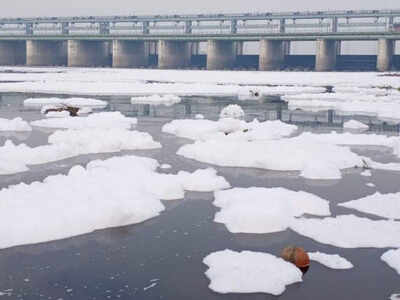
NEW DELHI: High phosphate levels, primarily due to use of domestic detergents, is causing frothing in the Yamuna, Delhi Pollution Control Committee informed the National Green Tribunal-appointed Yamuna Monitoring Committee, which had sought a detailed report on why frothing was being seen in the river.
Both DPCC and the Central Pollution Control Board had been asked to look into the matter last week, after images of froth in the river went viral on the social media.
DPCC officials conducted a site visit and detected froth at locations where there was a change in the level of the river, or where new water was being introduced. “The river was found to be having high phosphate content, which primarily comes from laundry detergents. There is no froth formation when there is a normal flow, but if there is a change in elevation or new water is introduced, the phosphate rises to the surface, mixing with the water to create foam on the surface,” a DPCC official explained.
On July 24, Delhi Jal Board had curtailed supply at Okhla, Wazirabad and Chandrawal water treatment plants due to the presence of high levels of pollutants in the Yamuna.
DPCC officials claimed there is no immediate solution to the problem, with an increased flow of water likely to help reduce the froth. “ In the long term, only the completion of tapping each drain with Sewage Treatment Plants (STPs) will remove this problem,” the official added.
“A large chunk of the pollution in the river actually comes from domestic sewage and not industries. Tapping both sources is essential and that will still take a couple of years. Until then, frothing will continue to occur at times,” said the official.
Yamuna Monitoring Committee, which had been appointed by NGT in 2018 to rejuvenate the river, was re-appointed last month and has since directed CPCB and DPCC to carry out monthly monitoring of the Yamuna and to provide data each month.
Both DPCC and the Central Pollution Control Board had been asked to look into the matter last week, after images of froth in the river went viral on the social media.
DPCC officials conducted a site visit and detected froth at locations where there was a change in the level of the river, or where new water was being introduced. “The river was found to be having high phosphate content, which primarily comes from laundry detergents. There is no froth formation when there is a normal flow, but if there is a change in elevation or new water is introduced, the phosphate rises to the surface, mixing with the water to create foam on the surface,” a DPCC official explained.
On July 24, Delhi Jal Board had curtailed supply at Okhla, Wazirabad and Chandrawal water treatment plants due to the presence of high levels of pollutants in the Yamuna.
DPCC officials claimed there is no immediate solution to the problem, with an increased flow of water likely to help reduce the froth. “ In the long term, only the completion of tapping each drain with Sewage Treatment Plants (STPs) will remove this problem,” the official added.
“A large chunk of the pollution in the river actually comes from domestic sewage and not industries. Tapping both sources is essential and that will still take a couple of years. Until then, frothing will continue to occur at times,” said the official.
Yamuna Monitoring Committee, which had been appointed by NGT in 2018 to rejuvenate the river, was re-appointed last month and has since directed CPCB and DPCC to carry out monthly monitoring of the Yamuna and to provide data each month.

Coronavirus outbreak
Trending Topics
LATEST VIDEOS
City
 'Wanted to teach Hindus a lesson' using political power, ex-AAP councillor Tahir Hussain confesses
'Wanted to teach Hindus a lesson' using political power, ex-AAP councillor Tahir Hussain confesses  48-hour countdown to Ram Mandir Bhumi Pujan in Ayodhya; invitation cards sent
48-hour countdown to Ram Mandir Bhumi Pujan in Ayodhya; invitation cards sent  UP CM Yogi Adityanath takes stock of preparations in Ayodhya ahead of Ram Temple bhumi pujan ceremony
UP CM Yogi Adityanath takes stock of preparations in Ayodhya ahead of Ram Temple bhumi pujan ceremony  J&K: Army Jawan abducted from Kulgam, vehicle set ablaze; massive search operation launched
J&K: Army Jawan abducted from Kulgam, vehicle set ablaze; massive search operation launched
More from TOI
Navbharat Times
Featured Today in Travel
Get the app





